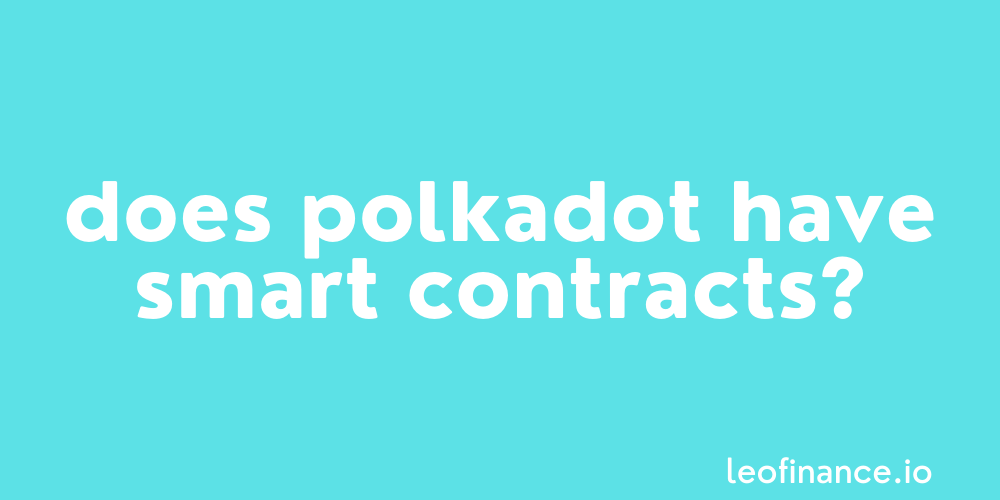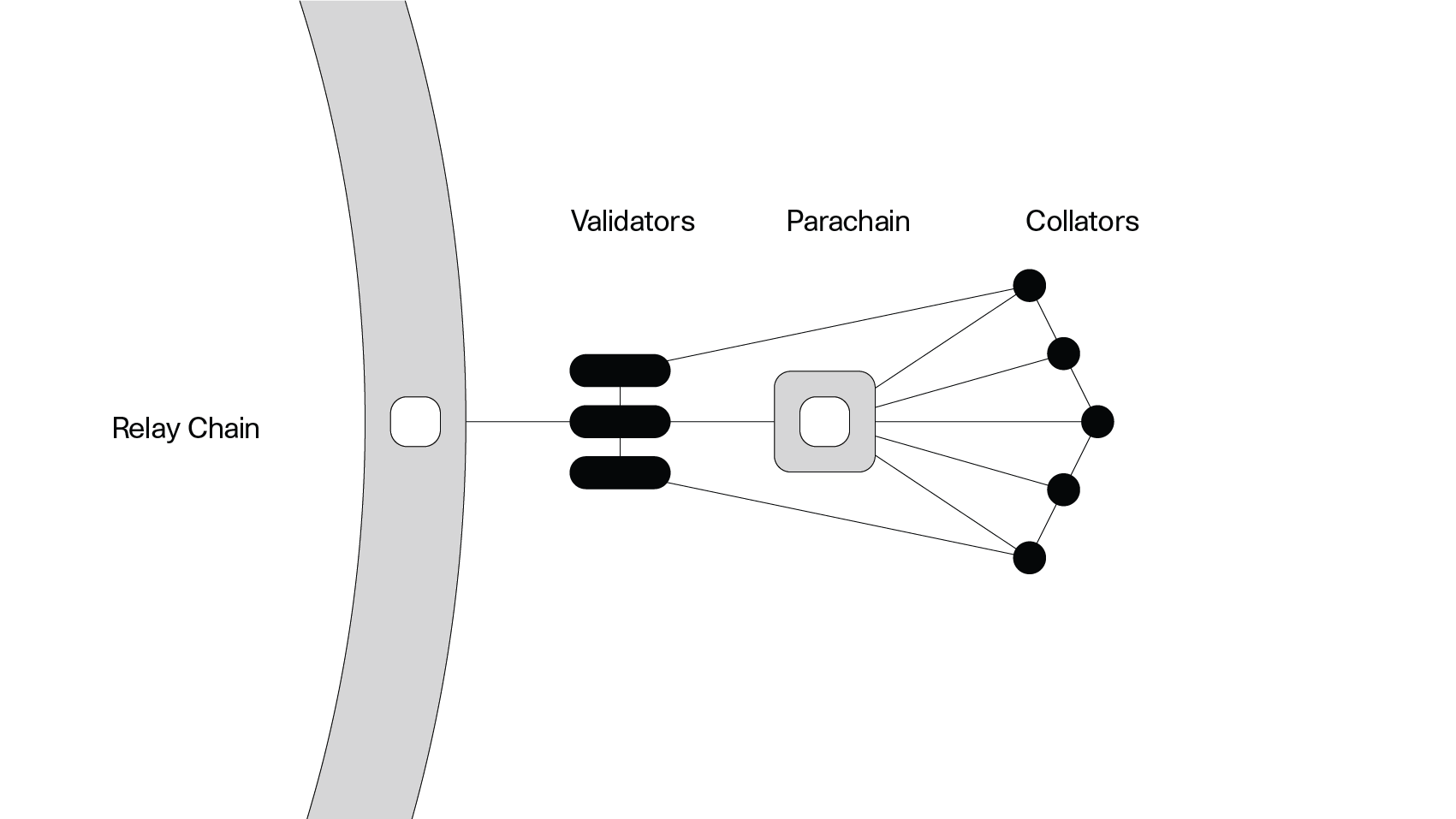
Parachains on Polkadot have smart contract capabilities, but the Polkadot relay chain itself does not.
Polkadot itself is not a smart contract platform, but a network that connects heterogeneous blockchains.
Polkadot is a sharded multichain network which means that transactions can be processed on several chains at the same time.
These connected blockchains are what’s known as parachains.
As a result, scalability is vastly improved when compared to traditional smart contract blockchains such as Ethereum and the like.
So while the Polkadot relay chain itself does not technically offer support for smart contracts, Parachains that are built on Polkadot do have smart contract capabilities.
This subsection of our Poldadot guide discusses the concept of parachains on Polkadot and what this means when it comes to smart contracts.

The Relay Chain - No smart contract capabilities...
The relay chain can be thought of as the primary chain of Polkadot and does not have smart contract capabilities.
It forms what you could call the central artery of Polkadot, and is responsible for the following functions:
- Shared security
- Consensus
- Cross-chain interoperability.
As you can see, only a relatively small number of transaction types exist in the relay chain, mostly centred around interacting with the governance mechanism and participating in consensus.
The relay chain on Polkadot is designed to have the minimal functionality that you see here, instead leaving the fun stuff like smart contract capabilities to parachains.
Polkadot validators stake their native token (DOT) on the relay chain to verify transactions from connected parachains.
The relay chain’s sole responsibility is to secure and coordinate the entire system.
Parachains - Smart contract capabilities!
Parachains are independent layer-1 blockchains that feature smart contract capabilities,
Taking their name from the fact they run in parallel to one another and the Polkadot relay chain itself, each Parachain features different:
- Designs
- Tokenomics
- Functionality
- Governance
As they’re still connected to Polkadot via the relay chain, parachains are able to preserve the security that comes with it, while retaining full control.
In addition to tokens and data exchange, Parachains do not need to bootstrap their own validator communities.
Being completely separate layer-1 blockchains, this is a key scaling differential that Polkadot has against its main competitor Ethereum.
Ethereum for example has gone down the layer-2 route to scale, with blockchains such as Polygon worth a further look when you get a chance.
Final thoughts on Polkadot’s smart contract capabilities
As you can see, Polkadot’s smart contract capabilities come from parachains rather than the relay chain itself.
If you’re running a high-traffic, high-throughput dApp with a large number of users, deploying on Polkadot is extremely economical.
Polkadot offers the flexibility and freedom of having your own layer-1 blockchain, without being forced to pass gas fees on to their end-users.
Thus making dApps that run on Polkadot parachains extremely simple and user friendly.
Best of probabilities to you.
Direct from the desk of Dane Williams.
Why not leave a comment and share your thoughts on Polkadot’s smart contract capabilities within the comments section below? All comments that add something to the discussion will be upvoted.
This Polkadot coin blog is exclusive to leofinance.io.
Posted Using LeoFinance Beta
This was pretty informative about Polkadot. It's quite different that they are scaling on the 1st layer rather than the 2nd layer.
Posted Using LeoFinance Beta
Yeah, digging into all these Ethereum competitors has been pretty informative.
They're all going about solving the same problem, in vastly different ways.
Polkadot's tech is actually awesome.
Posted Using LeoFinance Beta
Enjoyed reading this one. Thank you!
Posted Using LeoFinance Beta
You're welcome mate.
Happy to keep adding value to the LeoFinance community.
Posted Using LeoFinance Beta
Great insight on the Polkadot architecture and something new to learn today. Making your dapp on it and use your own layer-1 blockchain and tokenization is something an advantage from a cost point of view.
Posted Using LeoFinance Beta
Yep, Polkadot's tech is really cool when you go down the rabbit hole.
It wasn't a blockchain I thought too much about before doing some research for this crypto guide, but I'm glad I did.
Really interested to see where the project goes from here.
PS. Congrats on the curator position mate.
You've been a pillar of our community for as long as I can remember and I know you will do us all proud.
Posted Using LeoFinance Beta
Awesome. I didn't know Polkadot has two kinds of scalability solutions available. Is there any plan to release more solutions like Polygon is doing?
Posted Using LeoFinance Beta
Do you mind going into a bit more detail around the Polygon comparison?
Posted Using LeoFinance Beta
Sure. A seperate blog Polkadot vs Polygon? So now I have three topics to write on DOT.
Posted Using LeoFinance Beta
You said: "Polkadot offers the flexibility and freedom of having your own layer-1 blockchain, without being forced to pass gas fees on to their end-users".
That's right, but there are only 100 parachains and hiring one of them costs a fortune!
Yep, you're right.
Gaining 1 of those 100 parachain slots isn't cheap or easy.
But do you know whether there will be more slots opening up in the future, or if that's it?
All I can find around expanding is vague wording like the number of slots is flexible and subject to change.
Posted Using LeoFinance Beta
That's all I know as well, but the point is that the current rely chain only can support 100 parachains, so if they want to implement more they'll need either to update it or build another one. Taking into account that they are still auctioning the first parachains, there is a long road ahead before they start even thinking about deploying more. Anyway, I see Polkadot as a kind of private Internet of blockchains reserved just for wealthy people and high tech developers, so they don't have the vision of a widespread adoption, like for example Cardano.
I think this is the future of the blockchain, since having smart contracts can develop many things and the more economical and faster, the more dapps can be developed.
Posted Using LeoFinance Beta
Yep, smart contracts will be extremely important for blockchains going forward.
So just to be clear with Polkadot, their parachains do have smart contract capabilities.
But the relay chain of Polkadot itself does not.
Posted Using LeoFinance Beta
Congratulations @forexbrokr! You have completed the following achievement on the Hive blockchain and have been rewarded with new badge(s) :
Your next target is to reach 7500 comments.
You can view your badges on your board and compare yourself to others in the Ranking
If you no longer want to receive notifications, reply to this comment with the word
STOPTo support your work, I also upvoted your post!
Check out the last post from @hivebuzz:
Stop.
Posted Using LeoFinance Beta
Notifications have been disabled. Sorry if I bothered you.
To reactivate notifications, drop me a comment with the word
NOTIFY